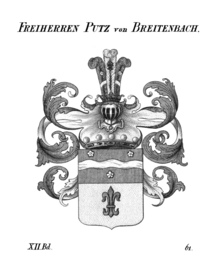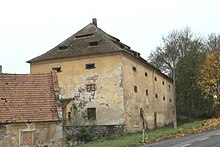Franz Xaver Putz from Breitenbach
Freiherr or Baron Franz Xaver Putz von Breitenbach , Herr auf Luck, Buda, Werscheditz and Libkowitz (born February 13, 1737 in Luck ; † August 9, 1794 in Libkowitz ) was a Bohemian nobleman and landowner who was raised to the baron status.
Life
Franz Xaver Putz (Christian name: Franciscus Xaverius Wenceslaus Antonius Joannes Nepomucenus ) was the youngest surviving son of the landowner Wenzel Leopold Ritter Putz von Breitenbach (1688–1747), Lord of Luck, Reschwitz , Buda and Chiesch, and his wife Antonia Theresia nee. von Hard (around 1697–1755). His grandfather was the mountain master of plates Christoph Adalbert Putz (1658–1726), who got rich with the production and trade of glass and blue paint and in 1719 with the title of Breitenbach from the emperor Karl VI. received the knight's diploma.
After the death of his father, his older brother Johann Nepomuk inherited the estates of Luck, Buda and Chiesch . In 1758 these goods passed into his possession. On 24 June 1758 he also acquired the Good Werscheditz of the widowed Maria Elisabeth Kfellner born of Saxony Green Countess Caretto von Millesimo for 55,000 florins. He combined the goods to form the allodial rule Werscheditz. From 1761 to 1765 he lived in Prague. He had to auction the Chiesch estate on March 14, 1766 due to high debts. It went to Count Prokop I. Lažansky for 110,400 florins. On September 14, 1767, he received the baron diploma from Emperor Joseph II in Vienna.
In 1774 he acquired together with Anton von Klement from the imperial count Ludwig von Hartig the rule Libkowitz, consisting of Libkowitz and castle (the former knight seat of the lords of Libkowecz), Groß-Fürwitz, and Tepeles or Neu-Döplitz. On October 6, 1774 he finally sold his estates Luck, Buda and Werscheditz to Count Franz Anton von Nostitz-Rieneck for 115,846 florins and 40 kr. The upper color works in Breitenbach, which his grandfather had acquired in 1688 and which were the seat of the family , he sold in 1775 to the former factor of the factory Franz Anton Miesl.
In 1791 he had the parish building of the Nahorzeditz church rebuilt. Among the objects that are kept there is a decorated silver chalice with the initials FAPVBB for Franz Anton Putz von Breitenbach and the year 1725 . Possibly a gift that Franz Xaver Putz, after having acquired the Libkowitz estate in 1774, made the responsible parish. He died on August 9, 1794 at Libkowitz Castle.
After his death, Gut Libkowitz came to Bernard Wenisch in 1805. His son Johann Putz von Breitenbach lived in Prague and was married to the much younger Elisabeth, a daughter of Joseph Ritter Stransky von Stranka and Greifenfels. The couple maintained contacts with Carl Maria von Weber , who was the opera director at the Estates Theater in Prague at the time and who mentions the Breitenbach family several times in his diary entries.
family
Franz Xaver Putz was married to Anna Regina geb. von Loskany (* around 1741 in Stein, † July 1, 1801 in Libkowitz). The following children are known:
- Antonia Theresia Joann: Nepom: Casimira (died March 4, 1761 in Prague St. Nikolaus); ⚭ June 10, 1801 in Nahorzeditz Vinzenz von Grünersberg, official director of the Luditz estate.
- Joann Nepomucenus Franciscus de Paula Procopius Wenceslaus (died May 28, 1765 in Prague Maria Teyn; † December 5, 1819 ibid); ⚭ August 7, 1810 in Prague St. Nikolaus Elisabeth Stransky von Stranka and Greifenfels
- Franciscus Xaverius Wenceslaus Leopoldus Franciscus de Paula Simon et Judas (born October 14, 1771 in Werscheditz, † July 5, 1780 in Libkowitz)
- Regina Josepha Kunigunda (born March 3, 1774 in Werscheditz)
See also
Individual evidence
- ↑ Nahořečice 05 | Porta fontium. Retrieved May 7, 2018 .
- ↑ Jaroslaus Schaller: Topography of the Kingdom of Bohemia ...: Th. Ellbogner circle . W. Piskaczek, 1785 ( google.de [accessed on May 7, 2018]).
- ↑ Jaroslaus Schaller: Topography of the Kingdom of Bohemia: it describes all cities, towns, lordships, manors, castles, country estates, noble estates, monasteries, villages, as well as dilapidated castles and cities under the former and current names including their peculiarities . Normalbuchdruckerey, 1785 ( google.de [accessed on May 7, 2018]).
- ↑ Wiesław Długosz: Listy herbowe i szlacheckie. Retrieved May 8, 2018 .
- ^ Karl Franieck: Weekly newspaper for Karlsbad and the surrounding area . Franiek, 1876 ( google.de [accessed May 7, 2018]).
- ↑ Johann Gottfried Sommer: The Kingdom of Bohemia: bd. Elbogner Kreis. 1847 . JG Calve, 1847 ( google.de [accessed May 7, 2018]).
- ↑ Elbogner Kreis: 15 . Ehrlich, 1847 ( google.de [accessed on May 8, 2018]).
- ↑ Jaroslav Vyčichlo: Nahořečice - kostel sv. Václava | Památky a příroda Karlovarska. Retrieved May 7, 2018 .
- ↑ Family calendar : to the ... year ...; which contains an alphabetical index of the high aristocratic families of the Kingdom of Boheim, their current descendants, accompanying batches, possessing lords and goods, then newly engraved coats of arms . printed and available from Franz Geržabeck, 1813 ( google.de [accessed on May 7, 2018]).
- ↑ Jiri Bernas: prihlasky Policejní. Retrieved May 12, 2018 .
- ↑ Nahořečice 24 | Porta fontium. Retrieved May 7, 2018 .
- ↑ Nahořečice 17 | Porta fontium. Retrieved May 7, 2018 .
- ↑ Nahořečice 02 | Porta fontium. Retrieved May 7, 2018 .
| personal data | |
|---|---|
| SURNAME | Plaster from Breitenbach, Franz Xaver |
| BRIEF DESCRIPTION | Bohemian nobleman and landowner |
| DATE OF BIRTH | February 13, 1737 |
| PLACE OF BIRTH | Luck |
| DATE OF DEATH | after 1775 |


